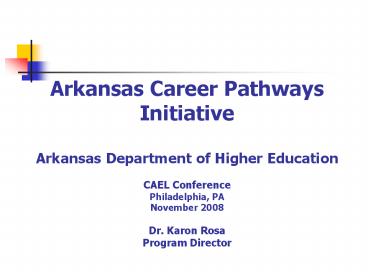Why Career Pathways Initiative - PowerPoint PPT Presentation
1 / 28
Title:
Why Career Pathways Initiative
Description:
Madison. Johnson. Yell. Garland. Montgomery. Pike. Dallas. Cleveland. Lincoln. Desha. Chicot ... Ashley. Boone. Clark. Clay. Cross. Drew. Fulton. Greene. Hot ... – PowerPoint PPT presentation
Number of Views:45
Avg rating:3.0/5.0
Title: Why Career Pathways Initiative
1
Arkansas Career Pathways Initiative Arkansas
Department of Higher Education CAEL
Conference Philadelphia, PA November 2008 Dr.
Karon Rosa Program Director
2
Arkansas Career Pathways Initiative
Charts a course for leveraging resources,
improving linkages among public systems, and
complementing existing services with new ones.
3
Purpose
- Provide an educational, work-based program that
will assist low-income people to gain skills that
lead to self-sufficiency. - Encourage upward educational and career mobility
for the target group of low-skilled, low-wage
workers.
4
Key Objectives
- Improve work participation rates
- Enhance basic skills
- Increase attainment of college-level certificates
and associate degrees - Improve job retention, advancement and wage
progression - Reduce welfare recidivism
- Increase self-sufficiency
5
Why Career Pathways Initiative?
- Arkansas was 49th in per capita income.
- Arkansass economy directly related to level of
education of citizens. - Only 29 of 18-24 year-old Arkansans are enrolled
in college. - Low-income young adultstwice as likely not to
attend college.
6
Arkansas Per Capita Personal Income as a Percent
of U.S. Average 1960-2005
Source Regional Economic Information System,
Bureau of Economic Analysis, U.S. Department of
Commerce
7
Per Capita Personal Income 2004
Source Bureau of Economic Analysis
8
Relationship Between Educational Attainment and
Personal Income 2000
Source U.S. Census Bureau, 2000 Census
9
Median Earnings by Degree Level 2005
Note Data represent persons age 25-64 with
positive earnings working 35 hours per week.
Source U.S. Census Bureau, 2005 PUMS
10
Arkansas Educational Attainment and Rank
(Percent) Among States
2005
Source U.S. Census Bureau, 2005 American
Community Survey (ACS)
11
Eligibility
Approximately 200,000 adults in Arkansas meet
eligibility requirements for the TANF funds that
are providing for the Career Pathways
Initiative.
12
Why Focus on Low-Income Adults?
- Working adults do not fit into traditional higher
education models. - Few Arkansas programs are developed for
low-income working adults. - Benefits accrue to everyone in state.
13
Arkansas Career Pathways Initiative
- 8 million for each state fiscal year from July
1, 2005 June 30, 2007. - 12 million for each state fiscal year from July
1, 2007 June 30, 2009. - Twenty-five sites at community colleges and
technical institutes.
14
Grant Awards to 25 Sites
- Grants range from 250,000-700,000
- Case-management model
- Curriculum re-design
- Student support services (Transportation,
Childcare, materials and supplies, tuition/fees
and textbooks) - Academic support services (Tutoring, mentoring,
internships, assessment)
15
What are Career Pathways?
- A framework for connecting a series of
educational programs with integrated work
experience and student support. - Enhanced student support services.
- Investments made in education are directly linked
to increased earnings through employer
partnerships. - A new way of doing business in our high schools,
colleges, and communities.
16
Features
- Redesign of curriculum and maps for each career
targeted for the Pathways program. - Enhanced wrap around student services to
increase student success. - Partnerships and Employer Involvement.
17
Features
- Credentials for specific occupations
- - Indicate skill levels to employers
- - Provide articulation of credits to
- other programs
- Internships for real-world experience
- Job placement services
18
Customized Curriculum
- Modular curriculum
- Multiple entry/exit points
- More flexible scheduling
- Alternative delivery systems
- Credential programs in series of modules
recognized by employers - Seamless transition between program levels
19
Customized Curriculum
- Accelerated learning
- Shorter units of studyFrequent testing
- Course work applied to job
- Classes at the workplace
- Seamless transition between programs
- Coordination with student support services
20
Redesigning Curriculum-Mapping Pathway
- Starts with employability skills and adult
education. - Bridge programs Applied learning in
- developmental or basic skills courses.
- Curriculum applied to local jobs.
- Conveniently scheduled classes for working
parents.
21
Pathways Career Map
22
Arkansas Targeted Job Categories
- Manufacturing
- Health care and social assistance
- Transportation and warehousing
- Professional and technical services
- Management of companies and enterprises
23
Partnerships and Employer Involvement
- Active partnerships for student support
- Economic Development strategy
- Employer validation of educational pathways
- Employer involvement
- Employers support for graduates
24
Enhanced Student Support
- Student Advising and Career Planning
- Internships
- College and Workforce Readiness and Prep
- Case Management
- Job Seeking
25
Sustainability
- Leadership at all levels
- Replicable models
- Utilize all funding sources
- Alignment of state and federal policy
26
Program Successes
- Student success rate of 90 in the second year.
- Over 12,000 adults enrolled.
- Over 5,000 certificate and degrees awarded.
27
Keys to Our Success
- Changing the Nature of On-Ground Service
Delivery. - Identifying the Needs of the Economy and Adapting
to Rapid Change. - Performance Measures and Incentive Funding.
- Reaching Out to TANF-eligible Workers and
Branding the Programs. - Improving Support Services for low-income and
low-skill adults. - A Dedicated Staff.
28
Arkansas Career Pathways Initiative Arkansas
Department of Higher Education 2008

